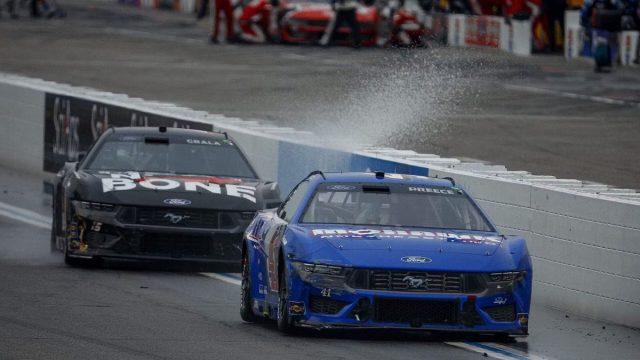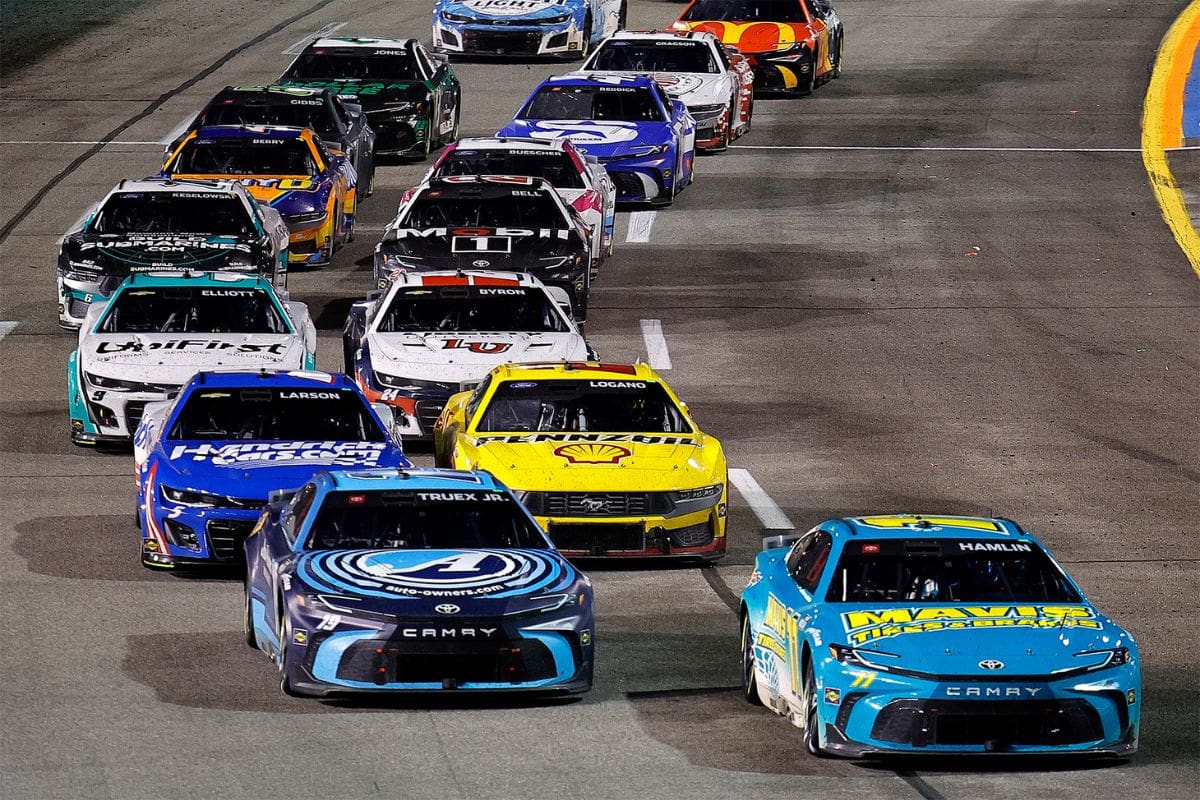NASCAR’s rainy day dreams collapse with Goodyear’s recent tire test for wet-weather racing, which did not go as planned and has left NASCAR’s plans to race in the rain in question. The goal was to improve grip and durability for larger ovals, but the results were disappointing. This could put a new wet-weather strategy at risk.
NASCAR Fans worry that the current tire designs might not work well, which could lead to more weather delays during races. As NASCAR tries to change its schedule and deal with challenges from the new NASCAR Next-Gen cars, this tire test could impact how they approach racing in the future.
Key Highlights
- Goodyear’s recent tire test at Homestead-Miami aimed to improve wet-weather performance but was deemed unsuccessful, raising concerns over durability and grip.
- The failure of the tire test undermines NASCAR’s proactive strategy to integrate wet-weather racing, potentially delaying schedule flexibility.
- Criticism of weather-related delays in NASCAR intensifies as effective wet-weather tires remain a challenge, hindering competitive racing in rainy conditions.
- The NASCAR Next-Gen car’s design issues contribute to frustrations, as drivers seek better performance and passing opportunities, particularly on shorter tracks.
- Near-identical vehicle designs limit competitive differentiation, exacerbating challenges faced in implementing effective wet-weather racing solutions.
Goodyear Prepares for Wet-Weather Racing on Larger Ovals Ahead of Martinsville
Goodyear’s proactive approach to wet-weather racing represents a remarkable shift in NASCAR’s tire strategy as it prepares for the upcoming playoff race at Martinsville Speedway. This small, short track has traditionally posed challenges during inclement weather, prompting Goodyear to conduct a tire test at Homestead-Miami. The focus of this test was not on the anticipated tire falloff but rather on optimizing performance under wet conditions, highlighting an emerging priority for the sport.
The shift toward wet-weather performance is indicative of a broader response to the increasing criticism regarding weather-related delays that have historically plagued NASCAR events. By exploring the viability of wet-weather tires for larger ovals, Goodyear may be laying the groundwork for a more flexible racing calendar, better equipped to handle unpredictable weather patterns.
However, the success of this initiative hinges on the performance of these new tires, particularly regarding grip and durability on larger ovals. The recent tire test serves as a crucial benchmark, yet the outcomes will ultimately dictate whether this innovation can be fully realized in future races.
As the NASCAR community keenly observes the developments leading up to Martinsville, the efficacy of Goodyear’s approach will be critical in shaping the future of wet-weather racing in NASCAR and could redefine the sport’s relationship with Mother Nature.
A Milestone in Wet-Weather Racing: Goodyear’s Push for Damp Track Conditions
The successful implementation of wet-weather tires during the 2024 USA Today 301 at New Hampshire Motor Speedway marked a notable advancement in NASCAR’s approach to racing under adverse conditions. This crucial event highlighted Goodyear’s initiative to introduce a tire compound specifically designed for damp tracks, allowing the race to finish without further interruptions following a two-hour delay.
The performance of these tires not only facilitated a safer racing environment but also raised considerable optimism regarding the future of wet-weather racing on oval circuits.
Key highlights from this milestone include:
- Initial Effective Use: Wet-weather tires were deployed on an oval track for the initial time, setting a precedent for future races.
- Successful Finish: Despite initial delays, the race wrapped up smoothly, demonstrating the reliability of the new tire compound.
- Victory for Bell: Christopher Bell’s success emphasized the competitive nature of wet-weather racing, as he adeptly navigated the challenging conditions.
- Future Implications: The race’s success suggests that NASCAR may increasingly adopt wet-weather racing, potentially altering the traditional scheduling and strategy.
As NASCAR continues to investigate the viability of wet-weather racing, the 2024 USA Today 301 stands as a landmark event that may redefine racing protocols and expectations in the face of inclement weather.
Goodyear Aims for Larger Ovals with Promising Results from Recent Tire Testing
Recent tire testing at Homestead-Miami Speedway has marked a notable step forward in NASCAR’s exploration of wet-weather racing capabilities on larger oval tracks. Building on the success achieved at New Hampshire, Goodyear’s recent exploratory tests aimed to evaluate tire performance on a 1.5-mile track, focusing on developing a plan for potential intermediate tires. According to FOX Sports reporter Bob Pockrass, the objective was to gather data that could inform future improvements in tire technology for wet conditions, potentially mitigating rain-related delays in the racing schedule.
“Wet weather tire test today at Homestead to see them on a 1.5-mile track. More of an exploratory test. Nothing planned for use in short term (like at least early next year) but mainly to develop a plan, if there can be one, of what they need to research/develop for intermediates.” – Bob Pockrass
Wet weather tire test today at Homestead to see them on a 1.5-mile track. More of an exploratory test. Nothing planned for use in short term (like at least early next year) but mainly to develop a plan, if there can be one, of what they need to research/develop for intermediates. https://t.co/XjPzY7ZwsY
— Bob Pockrass (@bobpockrass) October 28, 2024
This cautious yet progressive initiative aims to improve Goodyear’s offerings for larger ovals, indicating a commitment to enhancing safety and competitiveness in variable weather scenarios. The results from the Homestead-Miami tests may serve as a foundational analysis for future tire design and engineering efforts.
The insights gained from this testing phase are critical as NASCAR aims to navigate the complexities of racing in wet conditions. Goodyear’s commitment to research and development could herald a new era for the sport, improving its resilience against unpredictable weather.
NASCAR’s Wet Tires: Unique Design Offers Grip and Cool Performance Under Pressure
While NASCAR’s venture into wet-weather racing presents numerous challenges, the pioneering design of its wet-weather tires is engineered specifically to enhance grip and performance on slick surfaces. These tires are not merely adaptations of their slick counterparts; they exhibit a unique design that prioritizes safety and control in damp conditions.
Key features of NASCAR’s wet-weather tires include:
- Enhanced Tread Patterns: Similar to those found on passenger car tires, facilitating superior water expulsion and stability.
- Rapid Heat Generation: The tire compound is formulated to heat up faster than traditional slick tires, optimizing performance even in colder, wet conditions.
- Water Management: The water trapped between the treads serves a dual purpose: preventing overheating while enhancing contact with the track, thereby increasing grip.
- Data-Driven Development: The recent tire test at Homestead-Miami’s 1.5-mile track is a critical step in gathering data to inform future adjustments, especially as NASCAR examines the feasibility of larger ovals for wet-weather racing.
As NASCAR continues to refine its approach, the effectiveness of these tires will be paramount in shaping the future of wet-weather competition. The success of these tires could redefine the possibilities for racing in adverse conditions, ensuring that NASCAR remains at the forefront of motorsport technology.
Short-Track Package Struggles as NASCAR’s Next-Gen Car Continues to Divide Opinion
Amid ongoing debates within the NASCAR community, the Next-Gen car‘s performance on short tracks has emerged as a focal point of dispute. The inherent design limitations of the Next-Gen car have led to a noticeable reduction in passing opportunities on tracks measuring a mile or less, resulting in diminished racing quality. This scenario has intensified discussions regarding the viability of the current short-track package.
Despite multiple attempts to improve the Next-Gen car’s competitiveness, including the introduction of softer tire compounds and aerodynamic tweaks, satisfactory advancements have proven elusive.
Drivers like Kyle Larson have vocalized their frustrations, asserting that the challenges extend beyond tire performance. Larson’s comments, captured during a SiriusXM Radio interview, emphasize a broader issue: “Nobody has the answers… stop blaming Goodyear. It’s not a tire problem.” This sentiment reflects a growing consensus among drivers that the root of the problem may lie within the car’s fundamental design and its uniformity across teams.
“Nobody has the answers. Goodyear doesn’t have the answer. NASCAR doesn’t have the answer about their car and why it doesn’t run good in traffic. The drivers, the teams, and the engineers — we don’t have the answers either. We’re trying to crutch this race car on short tracks with the tire and then blame Goodyear every week cause cars can’t pass. I don’t have the answer to fix what we currently have and neither do you but please stop blaming Goodyear. It’s not a tire problem.” – Kyle Larson
As teams operate near-identical vehicles with minimal differentiators, the result is a stagnant competitive environment, particularly evident on shorter tracks where track position is paramount. The lack of diverse setups limits tactical opportunities, ultimately leading to less engaging racing.
As NASCAR navigates these challenges, the community remains divided on the Next-Gen car’s future, highlighting the critical need for creative solutions that restore excitement and competitiveness to short-track racing.
News in Brief: NASCAR’s Rainy Day Dreams Collapse
The challenges faced by Goodyear in tire testing for wet-weather racing emphasize the complexities of adapting to diverse track conditions within NASCAR. Despite advancements and promising designs aimed at enhancing performance on larger ovals, the inability to fully meet expectations raises concerns about the effectiveness of current strategies.
Additionally, the ongoing struggles with the short-track package highlight the broader implications of the NASCAR Next-Gen car‘s design, which continues to elicit mixed responses from stakeholders within the racing community.
ALSO READ: Homestead-Miami Track Gone? Fans Furious Over NASCAR’s Latest Move!



